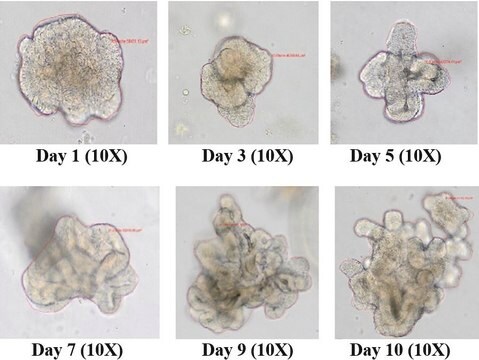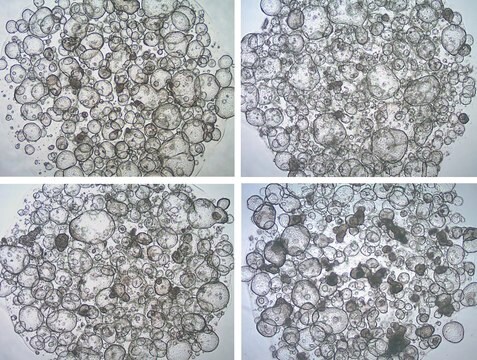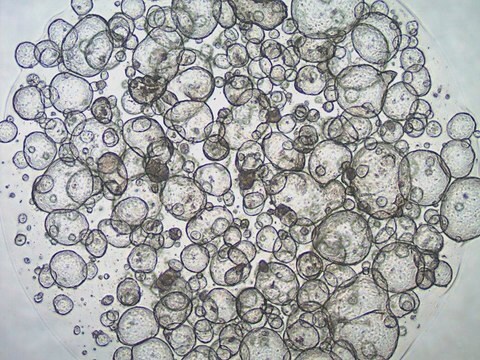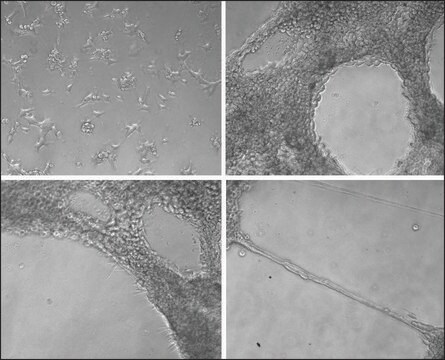SCM300
3dGRO® Organoid Dissociation Reagent
Chemically defined enzyme-free organoid dissociation solution.
Synonim(y):
Organoid passaging reagent
About This Item
Polecane produkty
Postać
liquid
metody
cell culture | stem cell: suitable
Opis ogólny
• Similar composition and architecture to primary tissue: Organoids harbor small population of self-renewing stem cells (such as intestinal crypt stem cells) that can differentiate into cells of all major cell lineages, with similar frequency as in physiological conditions.
• Relevant models of in-vivo conditions: Organoids are more biologically relevant to any model system and are amenable to manipulate niche components and gene expression.
• Stable system for extended cultivation: Organoids can be cryopreserved as biobanks and expanded indefinitely by leveraging self-renewal and the differentiation capability of the stem cell populations.
The 3dGRO Organoid Dissociation Reagent is a proprietary chemically defined enzyme-free dissociation solution used to passage multiple organoid cell types (etc. mouse intestinal organoids, human colon and lung organoids). Due to its chemically defined nature, the reagent produces consistent organoid passaging results. 3dGRO Organoid Dissociation Reagent can be used in combination with the 3dGRO R-Spondin-1 Conditioned Media Supplement (SCM104) to isolate and passage primary intestinal organoids from mice or in combination with the 3dGRO Human iPSC Derived Colon Organoid Expansion Medium (SCM304) to expand human iPSC derived colon organoids (SCC300).
Zastosowanie
Cell Culture
Stem Cell Research
Jakość
Osmolality: 340-370 mOsm
Sterility Tested: No Growth/Pass
Endotoxin; <2 EU/ml
pH: 7.2-7.4
Przechowywanie i stabilność
Informacje prawne
Oświadczenie o zrzeczeniu się odpowiedzialności
Kod klasy składowania
12 - Non Combustible Liquids
Klasa zagrożenia wodnego (WGK)
WGK 2
Temperatura zapłonu (°F)
Not applicable
Temperatura zapłonu (°C)
Not applicable
Certyfikaty analizy (CoA)
Poszukaj Certyfikaty analizy (CoA), wpisując numer partii/serii produktów. Numery serii i partii można znaleźć na etykiecie produktu po słowach „seria” lub „partia”.
Masz już ten produkt?
Dokumenty związane z niedawno zakupionymi produktami zostały zamieszczone w Bibliotece dokumentów.
Klienci oglądali również te produkty
Produkty
Human epithelial intestinal colonic organoids can be used as an alternative to Caco-2 drug permeability assays for drug screening and compound toxicity testing.
Najczęściej zadawane pytania dotyczące hodowli organoidów. Dowiedz się, jak hodować i analizować organoidy zgodnie z ustalonymi protokołami hodowli komórek 3D. Wskazówki i porady.
Produkty do hodowli organoidalnej do generowania trójwymiarowych modeli mózgu, jelit, jelit, płuc i guzów nowotworowych pochodzących z tkanek i komórek macierzystych.
Protokoły
How to stain organoids? A complete step-by-step protocol for immunofluorescent (IF) and immunocytochemical (ICC) staining of organoid cultures using antibodies
Jak wybarwiać organoidy? Kompletny protokół krok po kroku do barwienia immunofluorescencyjnego (IF) i immunocytochemicznego (ICC) hodowli organoidów przy użyciu przeciwciał
A rapid in vitro assay for CFTR function, the forskolin-induced swelling protocol uses human colon organoids, which can be derived from cystic fibrosis patient tissue.
Highly characterized cryopreserved human colonic organoids and a step-by-step organoid culture protocol for epithelial intestinal organoid differentiation from iPS cells.
Nasz zespół naukowców ma doświadczenie we wszystkich obszarach badań, w tym w naukach przyrodniczych, materiałoznawstwie, syntezie chemicznej, chromatografii, analityce i wielu innych dziedzinach.
Skontaktuj się z zespołem ds. pomocy technicznej












